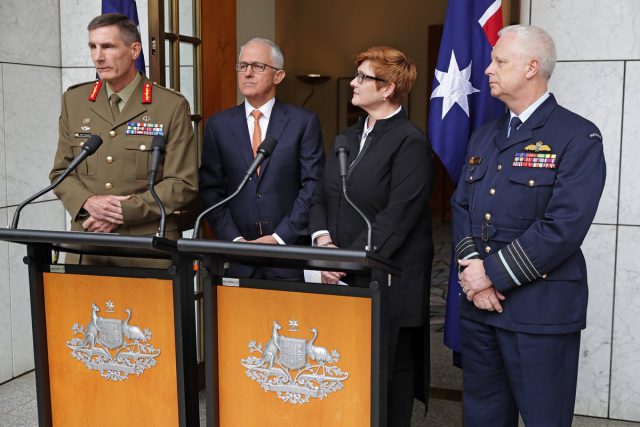Australia’s new military leadership: a view from America
Posted By Nathan Finney on April 20, 2018 @ 12:30

While seconded to the Australian Strategic Policy Institute last year, one of the most engaging topics for discussion around Canberra was who would become the new chief and vice chief of the ADF, and of the services .
It was a veritable game of thrones, where those ‘in the know’ confidently whispered their choices based on this meeting or that metric, while those most certainly not ‘in the know’ (including myself) listened intently or whispered their personal preferences based on interactions with possible contenders.
On Monday Prime Minister Malcolm Turnbull and Minister of Defence Marise Payne announced the senior leaders for the ADF [1], including Lieutenant General Angus Campbell as Chief of the Defence Force (CDF), Vice Admiral David Johnston as VCDF and Major General Rick Burr as Chief of Army (CA).
There are a few key things I think these selections can tell us, at least from an outsider/ally perspective. Michael Shoebridge covered the sound reasoning for the appointment of the new VCDF [2], including his robust operational background as the most recent Chief of Joint Operations, so I’ll refrain from retreading that ground.
So what does the elevation of Lieutenant General Campbell to CDF and Major General Burr to CA tell us? First, that Defence has largely been on the right track and continuity matters. Both army senior leaders are well known in Russell and Canberra generally, and to US allies in the Pacific.
Both men have close and robust working relationships with Admiral Harry Harris, the outgoing US Pacific Command [3] commander who has been nominated to be ambassador to Australia, as well as the US Army component commander, General Bob Brown, who I’m sure will discuss the importance of these relationships on his upcoming visit to Australia.
Additionally, Generals Campbell and Burr have shepherded robust modernisation and training programs that have set a solid foundation for the Army’s future (and a focus on Australian defence industry self-reliance, in line with Minister Christopher Pyne’s remit), while growing and challenging the interoperability of allied capability in exercises like Talisman Sabre.
Second, these appointments indicate a continued need for trusted and politically savvy (but not political) senior leaders to help shape the ADF’s future. Within hours of the announcement, newspapers were already salivating over Lieutenant General Campbell’s appointment, focusing on one aspect of his career [4]—namely his time as the commander of Operation Sovereign Borders [5].
While even as an outsider I understand this approach, I believe both his job as a national security adviser in the Department of the Prime Minister and Cabinet and, most recently, as army chief are better discriminators. In both jobs he displayed characteristics I was lucky enough to see up close while in Canberra, including a keen and penetrating intelligence, a dedication to his professional duties as a public servant and senior military leader, and a genuine desire to do what’s best for Australia as a member of a diverse national security community.
He used these character traits to slowly and quietly transform his own service, while working to influence the department as a whole. This is an approach I believe Major General Burr will continue when he takes over as CA, doubling down on successes from the last few years, while adding his own thoughtful ideas and priorities. Both leaders worked seamlessly together, and General Burr holds the same characteristics of intelligence, professionalism and teamwork that will drive continuity—in the best sense—for the Army in the years ahead.
Finally, from what I saw while interacting with both men last year, the best news in their appointments is in their focus on the ‘human dimension’. One of the greatest achievements, from my perspective, of Generals Campbell and Burr as a leadership team was their shift of Army culture to focus on the development of people—as individuals and as a diverse group of Australians.
From increasing educational opportunities to improving training, promoting army leaders who could push professional military education, to supporting junior leader-led initiatives (including entertaining ideas and generously providing time to temporary visitors from abroad), both leaders haven’t only the temperament, but also the drive to empower and push their people and their institutions to achieve their full potential.
While this factor wasn’t why they were chosen for their new positions, it’s likely to have the greatest impact on the ADF today and well into the future.
So, while it doesn’t matter what a humble American has to say about the future leadership of the Australian Defence Force, I’ll say it anyway—well done. Your men and women in uniform will be well served in the next few years.
Article printed from The Strategist: https://www.aspistrategist.org.au
URL to article: https://www.aspistrategist.org.au/australias-new-military-leadership-view-america/
URLs in this post:
[1] announced the senior leaders for the ADF: https://www.malcolmturnbull.com.au/media/press-conference-with-the-minister-for-defence-senator-the-hon.-marise-payn
[2] appointment of the new VCDF: https://www.aspistrategist.org.au/angus-campbell-david-johnston-two-appointments-three-key-leadership-challenges/
[3] US Pacific Command: http://www.pacom.mil/
[4] focusing on one aspect of his career: https://www.smh.com.au/politics/federal/operation-sovereign-borders-chief-angus-campbell-to-become-australian-defence-force-chief-20180416-p4z9ui.html
[5] Operation Sovereign Borders: http://osb.homeaffairs.gov.au/
Click here to print.